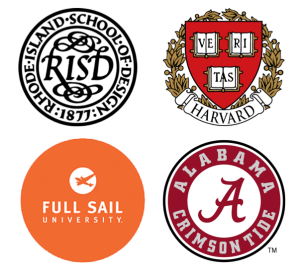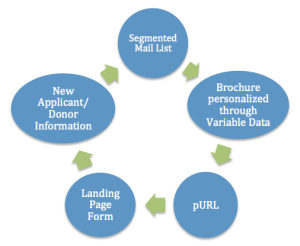Content Marketing in Higher Education
Higher Education Marketing Trends
Colleges and universities are constantly preparing or launching their next cycle of marketing campaigns aimed at both prospective applicants and donors. Each school will go about its campaigns in slightly different ways, as each hopes to highlight some standout or differentiating facet of its programs. And of course, as in any industry, colleges and universities span a vast spectrum of size, budget, and technological capabilities. The colleges and universities with the largest endowments have the ability to spend the most on marketing, and use complicated and expensive products overflowing with channels and analytical features. On the other end, the marketing departments of the small to mid-sized institutions do not have the same human and financial resources at their disposal, often limiting their efforts to just one or two channels.
and universities are constantly preparing or launching their next cycle of marketing campaigns aimed at both prospective applicants and donors. Each school will go about its campaigns in slightly different ways, as each hopes to highlight some standout or differentiating facet of its programs. And of course, as in any industry, colleges and universities span a vast spectrum of size, budget, and technological capabilities. The colleges and universities with the largest endowments have the ability to spend the most on marketing, and use complicated and expensive products overflowing with channels and analytical features. On the other end, the marketing departments of the small to mid-sized institutions do not have the same human and financial resources at their disposal, often limiting their efforts to just one or two channels.
Yet across all sizes of colleges and universities, there is one theme that unites all campaigns: branding. Branding is central to nearly every enrollment and fundraising effort. Schools want their names to be immediately associated with concepts that will drive both enrollment and donations from their target demographics. High academic standards, sports success, outstanding programs, and proof that degrees from their universities lead to brighter futures are popular selling points, but each institution will tailor its message slightly differently in order to better appeal to its chosen demographic segment. This form of marketing requires no distinct sales pitch; it’s all about building the institution’s brand visibility and credibility. Therefore, higher education brand building is best supported by content marketing. Content marketing allows an institution to spread relevant information about itself without actually forcing a sales pitch on a prospective applicant or donor. The prospective applicant or donor will internalize the information and thus allow it to alter his or her perception of the brand, which quickly and inexpensively accomplishes the institution’s short-term branding and marketing goals.[Tweet “Higher Education Branding – It’s About Content Marketing”]
Content Marketing Defined
But what exactly is content marketing? It has become a marketing buzzword, but its exact definition can be hard to pin down. In short, content marketing is a company’s distribution of informative and helpful material that a given consumer will find interesting. There is no sales pitch in a content marketing campaign; rather, it is designed to inform the consumer about a topic related to the company’s product in a friendly and helpful way. It is intended to build a sense of trust and amicability between consumer and supplier outside of the realm of sales.
It is also clear that content marketing works. According to the Content Marketing Institute, 93% of B2B marketers use content marketing. First pioneered by the B2B market, it has now rapidly made its way to the B2C side, where it is still spreading as different industries find new uses for it. Consumers have been very receptive to it, with 70% of consumers claiming to feel closer to a company after viewing content, according to a DemandMetric survey. In fact, the same survey reported that 86% of B2C marketers are using some form of content marketing, and that number is growing.
Content Marketing in Higher Education

Across the range of B2C vertical markets there is no industry for which content is more important than content marketing in higher education. It is an incredibly competitive market for attracting targeted students and donors, a carefully tailored brand name goes a long way. Every institution is trying to appeal to slightly different segments of both donors and students, so subtleties in branding offer a great way for institutions to distinguish themselves from their peers.
When Advertising Age asked why branding is so important for a university, Northwestern University’s CMO Mary Baglivo replied, “Because the competition for the best and brightest students, faculty for transformational research and donor dollars is more competitive than ever . . . All of a sudden you have a much larger world to communicate to and [it’s necessary] to make your brand clear in a much broader universe.” Whatever the institution’s goal, whether it be attracting chemistry geniuses or funding a new football stadium, content marketing is just the tool to accomplish it. Just like Northwestern, every school has a target segment of donors and applicants, and proper branding helps to ensure the institution’s marketing success. A good content-based campaign will both reinforce the brand’s desired image and increase its broader visibility.
But creating an effective content marketing in higher education campaign is easier said than done. When segmenting prospective applicants and donors, universities have to deal with huge amounts of data ranging from SAT scores to donor histories. Higher education institutions must organize this data and then use it to effectively reach out to a vast and largely uninformed population: they can’t just send everyone a hand written invitation to apply or donate. First they must inform the consumer in a way that captures his or her attention. Sending overly sales-based, explicitly enrollment-oriented, or purely funds-oriented campaigns portrays a university as lifeless numbers-focused business, not the brand that they have worked hard to cultivate. Content regarding the institution’s programs, campus news, or school statistics is the answer, but how can a university convince an uninformed prospect to open and read through content?
Learn How To use Boingnet to Personalize Education Content Campaigns – Register for a 60 Day Free Trial!
Start Free Trial
Personalized Content Marketing in Higher Education
The solution is a personalized content marketing campaign. By addressing each potential donor or applicant individually without pressing a sales pitch on him or her, a university establishes a relationship of trust and friendliness in, ostensibly, the interest of the potential customer’s education. In fact, a report by DemandMetric showed that 82% of customers feel more positively about a company after receiving content customized to them. It also proves itself valuable for expanding a university’s brand visibility, as 70% of consumers prefer to learn about a company through personalized content rather than a generic advertisement, according to the Custom Content Council. Thus, adding the personal component vastly increases readership of content and proves to be the most effective and inexpensive means of brand management and dissemination.
Yet, again there is a problem. What exactly does personalization entail? The extent of personalization all depends on the strengths of the lists an institution is using. The more columns of data per name, the more personalized the content can be. Here is an example personalized content campaign:
A Sample Personalized Content Campaign
A college mails an informational brochure to a segment of prospective students based on a specific range of SAT scores. On the cover, each student’s name is printed as part of a friendly greeting, followed by some tagline specific to her home state or region. Inside the brochure (which she decides to open after seeing her name and home state on the cover) is informative and interesting information about the school.
As she reads, she finds a personalized URL (pURL) containing her name and promising her more custom content if she visits the page. Upon visiting the page, the student finds a prefilled form for her, asking for one more piece of information (for example intended area of study) before she can access the next round of custom content.If she does fill out the form, an automatic thank you email will be sent to her, further building the personal and friendly atmosphere within which she is viewing content. And whether or not she fills out the form, her visit to the page will be recorded, giving the college’s marketing team a lead for follow-up drip campaigns. These subsequent campaigns may be as specific as the marketer would like, potentially working off of the new information that the student filled out on her pURL. In this way, the college is able to share and develop its chosen branding strategy in a friendly, informational way. And, of course, this entire personalized content campaign scenario is highly adaptable. It could easily be replicated with different content if, for example, the college wanted to target prospective donors rather than prospective applicants.
Try Better Content Marketing For Free – Register for a 60 Day Free Trial!
Start Free Trial
Boingnet’s Role
And that’s where Boingnet can help. Our platform is perfectly suited to content marketing distribution and personalization. We can coordinate content marketing campaigns across direct mail, email, social media, and mobile, and then give it an extra personal touch with pURLs, custom landing pages and microsites, and easy to use variable logic. With the data we collect from content opens, click-throughs, and landing page forms, we lay the foundations of drip campaigns to continue the conversation with the desired segments of the initial campaign. Whether the university is reaching out to alumni networks or working to attract applicants, Boingnet’s software has it covered with our easy to use, straightforward user interface and surprisingly low prices. We want to help spread and develop a university’s brand to increase enrollment and donations, while at the same time solidifying that chosen brand’s position within the minds of its targeted students and donors.



